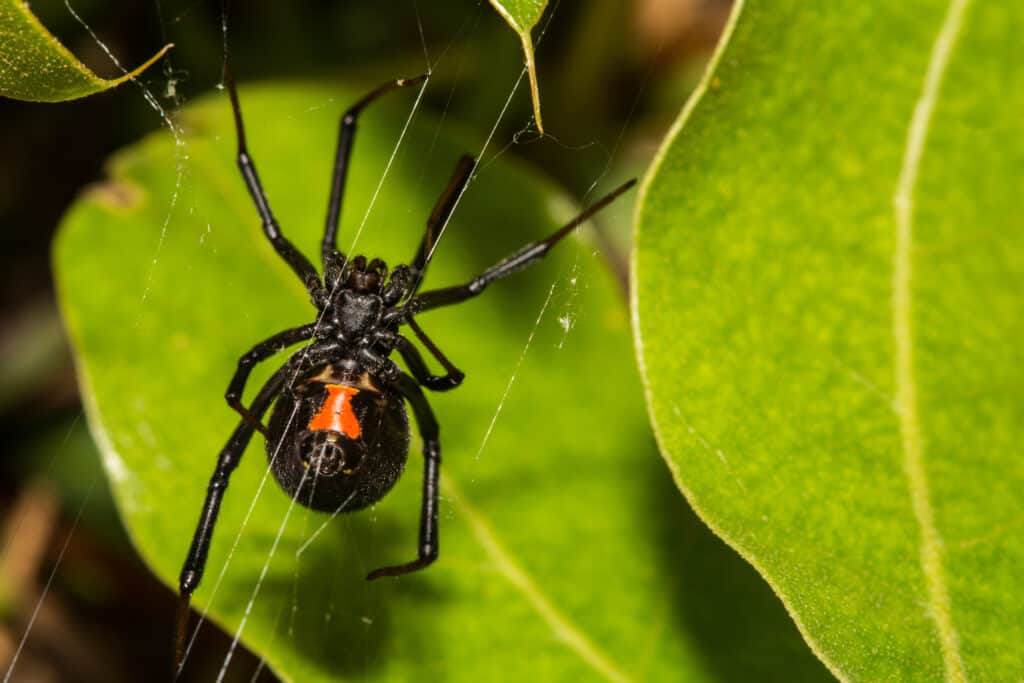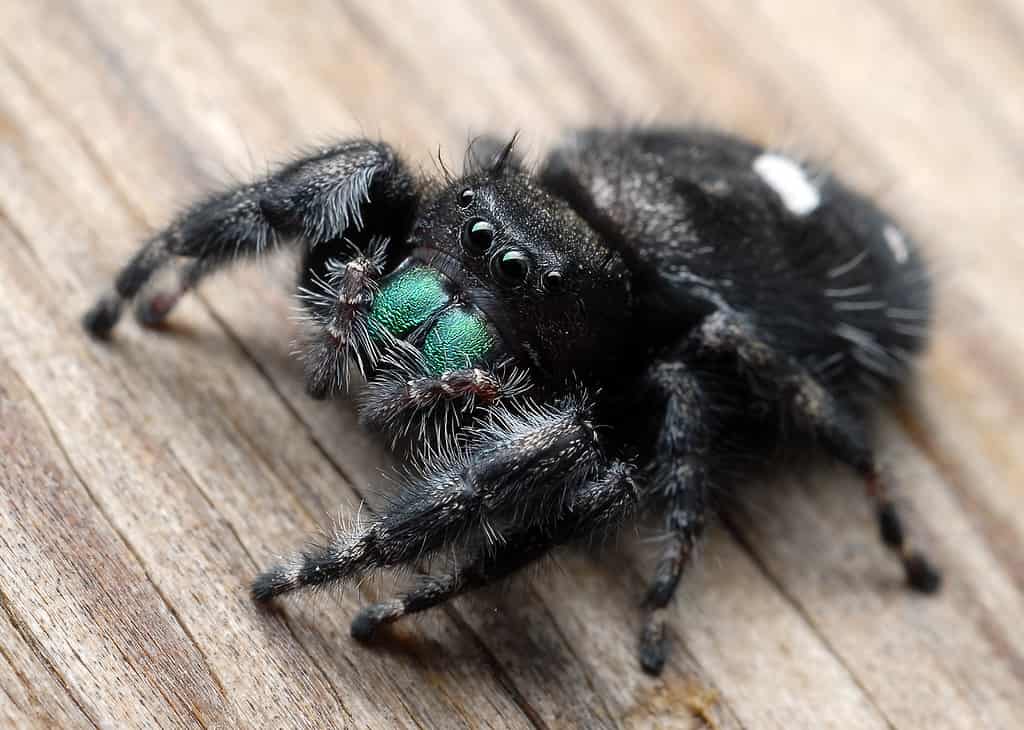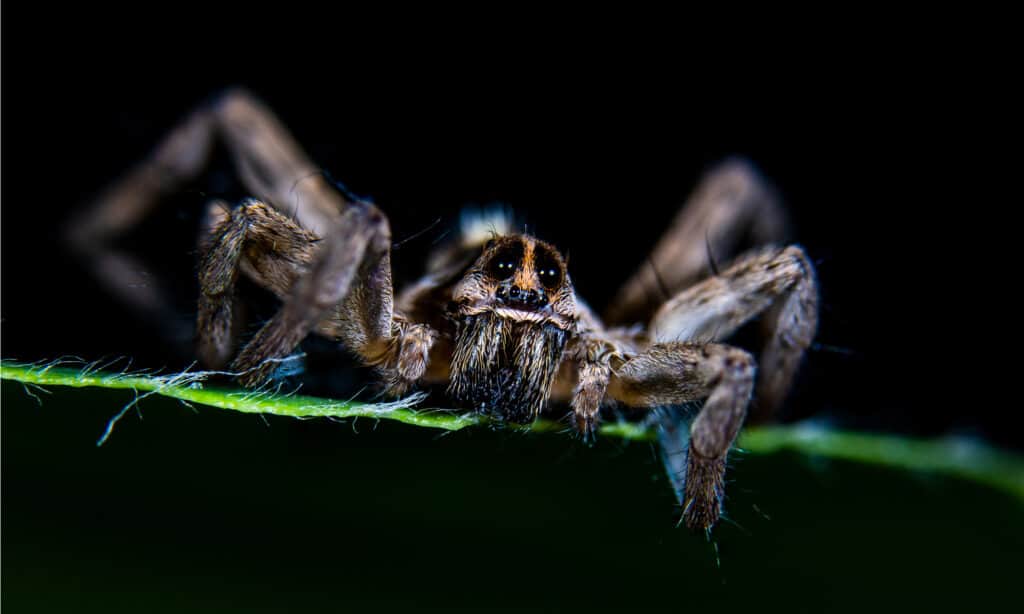Although fascinating and vital to the environment, spiders give many humans heebie-jeebies. These creepy crawlies have entire lives of their own, sometimes actively hunting and sometimes spinning webs to catch prey. Some of them are big, some of them are tiny, and some are boldly colored while others blend in. There are several spider species you can find in New Jersey, but in this article, we focus solely on black spiders!
Discover 5 Black Spiders in New Jersey
1. Black Widow
Scientific Name: Latrodectus
There’s nothing quite like the feared black widow spider. It’s native to North America, existing in every state except for Alaska. Most people fear these spiders because of their venom. A bite may require medical attention and could be fatal for children if not treated right away. Luckily, these spiders are not aggressive and only bite in response to a threat. The female spider is characterized by its bulbous abdomen, its shiny black color, and its red-marked belly. Usually, the shape is that of a small hourglass and the color is often red, though it may be on the lighter side, appearing orangish or yellowish. Male spiders have different appearances. Not only are they significantly smaller (about half the size of the female), but they also have longer legs. Their colorations deviate from the all-black appearance of the female. They’re more brown or gray and they also have tiny red spots.

The female black widow spider is characterized by its bulbous abdomen, its shiny black color, and its red-marked belly.
©Jay Ondreicka/Shutterstock.com
2. Bold Jumping Spider
Scientific Name: Phidippus audax
True to their name, these spiders can jump long distances! They’re active hunters so they need this skill as they go out to get their prey. They don’t weave webs to help them trap prey, instead, they use their tiny legs to hurdle them up 50 times their own body length to pounce on their prey. They plan ahead, too, casting a thread before they make that fateful leap in case they happen to miss the mark, they have a backup to snatch their prey. As is the case in the arachnid world, the female bold jumping spider is bigger than its male counterpart. Their coloration is primarily black, but they also have some cool hues that decorate their bodies, usually a metallic shade of bluish-green. Though tiny (with the females growing only up to 0.55 inches in length), these spiders are capable of biting! Although the bite is painful, you don’t have to worry as they are not venomous.

Bold jumping spiders will watch its prey and then pounce on its victim when the timing is right.
©Miles Boyer/Shutterstock.com
3. Wolf Spider
Scientific Name: Lycosidae
The wolf spider has both an intimidating name and an intimidating appearance. They got their common name from their abilities as hunters to pounce on their insect prey the way wolves pounce on their chosen prey. The females are the larger of the two sexes, and they grow up to 1 3/8 inches long. Their colorations serve to camouflage them and can be any iteration of black and brown. These spiders are startling but the best way to distinguish them from others is by checking their eyes. They have a total of eight eyes, and they’re spaced out in an interesting way. The top row has two medium-sized eyes, the middle row has two large eyes, and the bottom row has four smaller eyes. These spiders like dwelling in protected areas like under firewood and between boards — within these spaces, they construct little tunnels that they retreat into when they’re not actively hunting. These spiders aren’t innately aggressive and only bite if they feel threatened. Healthy adults recover quickly though the bite may be painful.

Wolf spiders in New Jersey can be any iteration of black and brown which helps to camouflage them.
©Marshal Hedin / Creative Commons – License
4. Parson Spider
Scientific Name: Herpyllus ecclesiasticus
The parson spider’s primary colors include black, brown, gray, and tan. They’re most commonly spotted during the month of May, but they do make appearances in other months throughout the year. These spiders move quickly and have distinctive markings on their abdomens that resemble a neck scarf. They are hairy, with grey hairs on their abdomens and black hairs on their cephalothoraxes. Just above their spinnerets is an additional white marking. They use their silk to line their retreat areas where they rest during the day. Under the cover of night, they emerge to hunt. These spiders bite but most of the time, this occurs when a spider is trapped between skin and clothes or blankets. The bite is painful but not medically significant (unless you have an allergic reaction).

The parson spider is black, brown, gray, and tan with distinctive markings on their abdomens that resemble a neck scarf.
©Kerry Hargrove/Shutterstock.com
5. Yellow Garden Spider
Scientific Name: Argiope aurantia
This spider has a look of its own. It’s black and yellow, with distinctive markings on its abdomen. It has eight legs, and the females grow larger than the males, reaching up to 1.10 inches long. They avoid the wind when they build their webs but they like setting up out in the open. Their webs are circular up to two feet in diameter and they create a dense middle with zig-zag shapes. The yellow garden spider’s bite is non-venomous to humans (unless you’re allergic) so typically, it’s not medically significant. The bite has been likened to the pain of a bee sting.

The yellow garden spider is black and yellow with distinctive markings.
©iStock.com/AwakenedEye
The photo featured at the top of this post is © Mircea Costina/Shutterstock.com
Thank you for reading! Have some feedback for us? Contact the AZ Animals editorial team.






